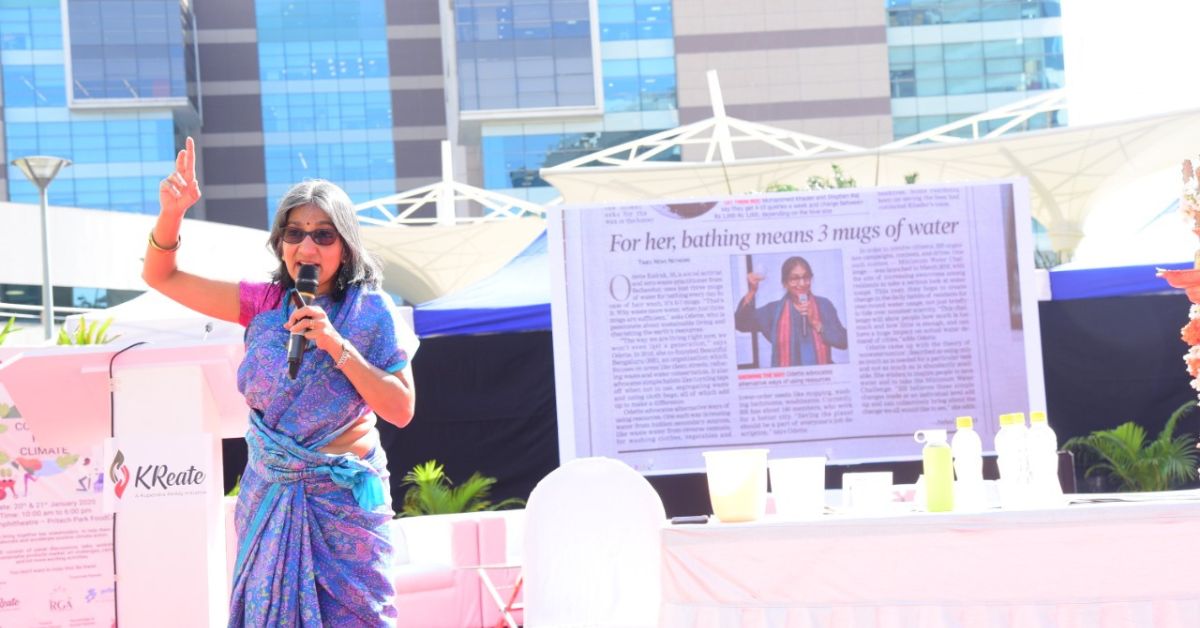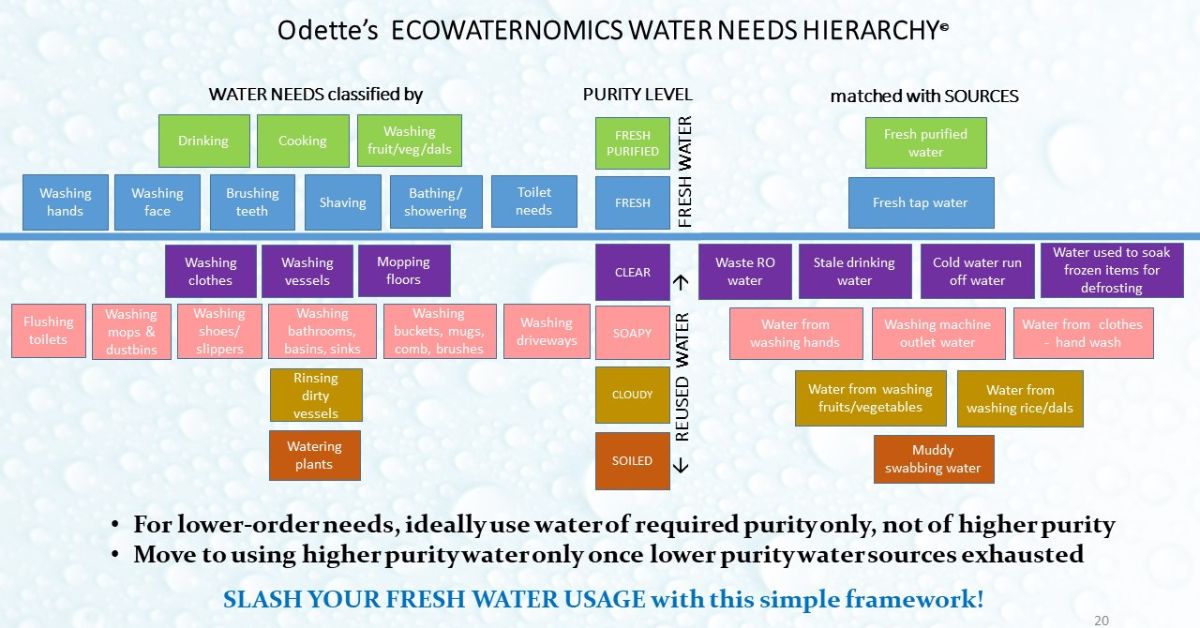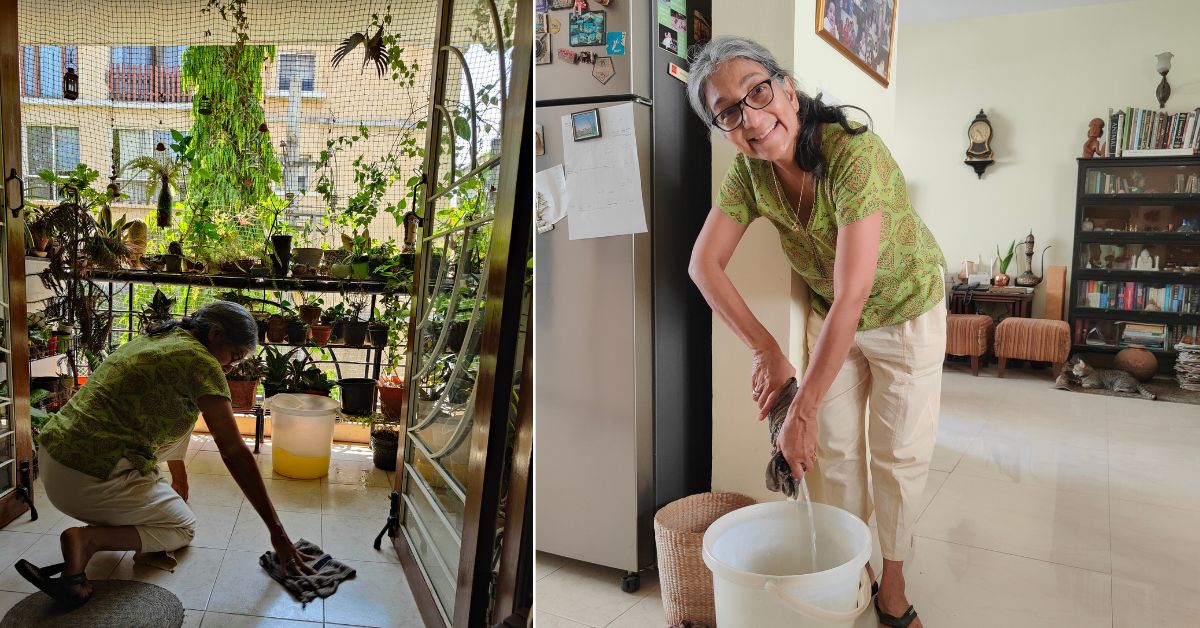Think about bathing with simply 3 mugs of water or having over 350 potted crops but not utilizing a single drop of contemporary water to water these?
These are some excessive water conservation measures that Odette Katrak, a Bengaluru resident, has been adopting for 15 years, because of her distinctive Ecowaternomics framework, which she hopes will encourage many to save lots of enormous quantities of water too.
“It took us a extreme water disaster in Bengaluru to grasp we have to save water,” she remarks. With 1000’s of public borewells operating dry, strict restrictions and penalties being imposed on the wastage of water, Bengaluru is going through a dire shortage of water.
“Whereas residents are chasing water tankers and taking fewer showers, many count on exterior options like rainwater harvesting, Sewage Remedy Crops (STP) and so on that enhance provide, as a substitute of parallel modifications within the family that scale back demand. Perhaps they discover it troublesome – that’s the place my framework helps,” she provides.
In the meantime for Odette, the genesis of water conservation set off 15 years again when she noticed a chilling presentation ‘Letter within the yr 2070’. It described a world with out water, the place you’d get only one glass of water to drink, be compelled to shave your head, and rub oil in your physique.

“These photographs shook me, forcing me to chop again drastically. Lavatory singing throughout earlier prolonged baths was one thing I had to surrender,” she laughs.
Shifting to Bengaluru 9 years again gave her extra causes to save lots of water. “My home neglected low revenue dwellings. I’d see ladies fetching water. One was even carrying her toddler, who was additionally armed with an empty bucket. With even young children being made to hold water, this gave a completely new worth to how valuable water is,” she tells The Higher India.
“These photographs positioned a accountability on me to save water judiciously. So, although water flows abundantly from my faucets, it’s also my accountability to preserve water as it’s a shared useful resource. This was additionally a turning level for me to not solely save water in my house but in addition make others perceive that simply because we will afford water tankers, it doesn’t imply we’re free to maintain losing water,” she provides.
To deal with the colossal neglect of water on the family degree, the 60-year-old has created a one-of-its-kind framework that may assist residents slash contemporary water utilization. With this easy method, she claims to make use of round 1500 litres much less water per day than an equal family.
She goals to make water-saving easy, and with a measurable consequence – everybody opens faucets much less for contemporary water, whereas nonetheless having sufficient for his or her wants along with her ‘Use much less, Reuse Extra’ system.
Three-mug tub problem
Rising up in a household of 9 in Chennai, Odette realized to make do with a naked minimal quantity of water, to tide over summer season shortages. “However once I began residing alone, I forgot these practices until I got here throughout that eye-opening video in 2009,” she says.
Understanding the necessity to preserve water, Odette began bathing utilizing three mugs of water. Almost 5 years again, she turned well-known for this. “I bathe with three mugs of water and sure, I don’t scent,” she provides laughingly.
“A good friend joked that no marvel autocorrect modifications Odette to Odour! Others teased that they’d cowl their nostril in the event that they run into me sooner or later. All taken in good humour, which helps get consideration to this topic. I reply that it’s good if folks suppose I exploit too little, they might begin realising that they use an excessive amount of!” she says.
Odette, who’s the co-founder of Lovely Bharat — a citizen-led motion to carry a few systemic social change within the mindset of individuals — runs a Save-water marketing campaign that features a Minimal Water Problem.

“With my three-mug problem, I’ve managed to place the thought in folks’s minds that three mugs of water is sufficient to bathe. Why use 20 litres of water, if three mugs will do! Earlier, I might use three mugs of water for normal baths and 6 mugs when washing my hair. Now I can do with three mugs for laundry hair and two mugs for normal baths. I accumulate that in a bath to make use of for flushing,” she says.
With this, Odette says she has been in a position to carry her water consumption whereas bathing down from 75 litres to three.6 litres every day. The truth is, that water can also be additional reused, demonstrating her ‘Use much less, reuse extra’ mantra in motion.
Slash water utilization with easy framework
Odette categorises the utilization of water right into a framework she calls ‘Ecowaternomics’, a water wants hierarchy, just like Maslow’s hierarchy of wants, primarily based on a hierarchical order.
She defines the idea as being economical with water utilization, utilizing solely the naked minimal that one wants, and never as a lot as is abundantly accessible. This may be achieved by two ideas: use much less and reuse extra. Utilizing much less is clear however wants reminding (low faucet circulate, faucet off when not wanted, no operating water, and no leaks).
Her subsequent query, “Would you bathe with mineral water?” emphasises the second a part of her system – to reuse extra. “We wouldn’t waste water of upper purity to wash, but all of us use contemporary water out of a faucet for laundry mops or rinsing soiled dishes when water of decrease purity works simply as simply,” she provides.
Based mostly on her calculations, she says most households require contemporary water for less than 30-40 p.c of their wants, remaining water wants may be met by reusing this water. “Water that you just let down the drain is all the time good for another function,” she suggests.
She factors out the hidden sources of water accessible on the family degree: water from washing fingers, rice/pulses, vegetables and fruit, waste RO water, water from defrosting, and washer outlet water. “Whereas these will not be match for consuming, they are often reused for different functions, even when clear, cloudy, soapy or muddy,” she provides.

(See slide: Ecowaternomics framework)
As an illustration, Odette provides that whilst you use contemporary purified water for consuming, cooking, and washing vegetables and fruit, you should utilize contemporary faucet water for laundry fingers and face, brushing tooth, shaving, bathing, washing garments, and bathroom wants. Apart from these functions, you possibly can reuse water.
“For each one litre of filtered water, RO wastes three litres of water. Sadly, many let this down the drain however it’s nonetheless clear water so can be utilized to mop flooring and wash vessels,” she explains.
“Making use of the hierarchy of wants precept, I can’t carry myself to make use of clear RO waste water on crops, as cloudy water collected from washing greens/dals works completely right here or for rinsing soiled dishes – once more why use water of a better purity than wanted! I exploit the rejected water from the RO for mopping after which reuse it once more for watering crops, probably as a result of I exploit natural cleaners,” she provides.
Curiously, Odette makes natural cleaners that make the water secure to reuse.
“In place of bathroom cleaners and flooring cleaners, I exploit do-it-yourself bio enzymes that can be utilized to wash bogs, flooring, and disinfect fruits. I reuse this to water my crops. Bio enzymes are helpful for crops because it acts as a fertiliser,” she says.

To make this natural cleaner, Odette says, combine three components of fruit peels with one a part of jaggery in 10 components of water in an hermetic jar, stirring every day to launch gasoline. “After six weeks, it’ll be prepared to make use of. It additionally leaves a wonderful aroma,” she provides.
In the meantime, soapy water from washing fingers, washer retailers, and garments can be utilized to flush bogs, washing mops/dustbins, bogs, washbasins, buckets, driveways, and so on.
Subsequent, Odette advises gathering cloudy water from washing fruits, greens, rice and pulses for use for rinsing soiled utensils. Lastly, muddy water from mops can be utilized to water crops.
Odette was requested, years again, if there may be any have to go to this excessive, for isn’t this all too drastic? “If all of us do extra of this now, future generations won’t be compelled to do that on a regular basis,” she had replied.
And that situation is nearer than anybody anticipated, she says.
“Not simply Bengalureans, however saving water is one thing everybody throughout cities may make a year-round behavior – water ranges are depleting all over the place. Why look ahead to a water disaster to start out. Let’s use water as fastidiously as we might if we needed to first carry it, like these ladies that I’d described. As a result of each drop does rely!” she concludes.
To assist Odette’s marketing campaign to save lots of water and comparable campaigns for the surroundings and a Lovely Bharat, join on Instagram @odettekatrak or @beautifulbharatorg.